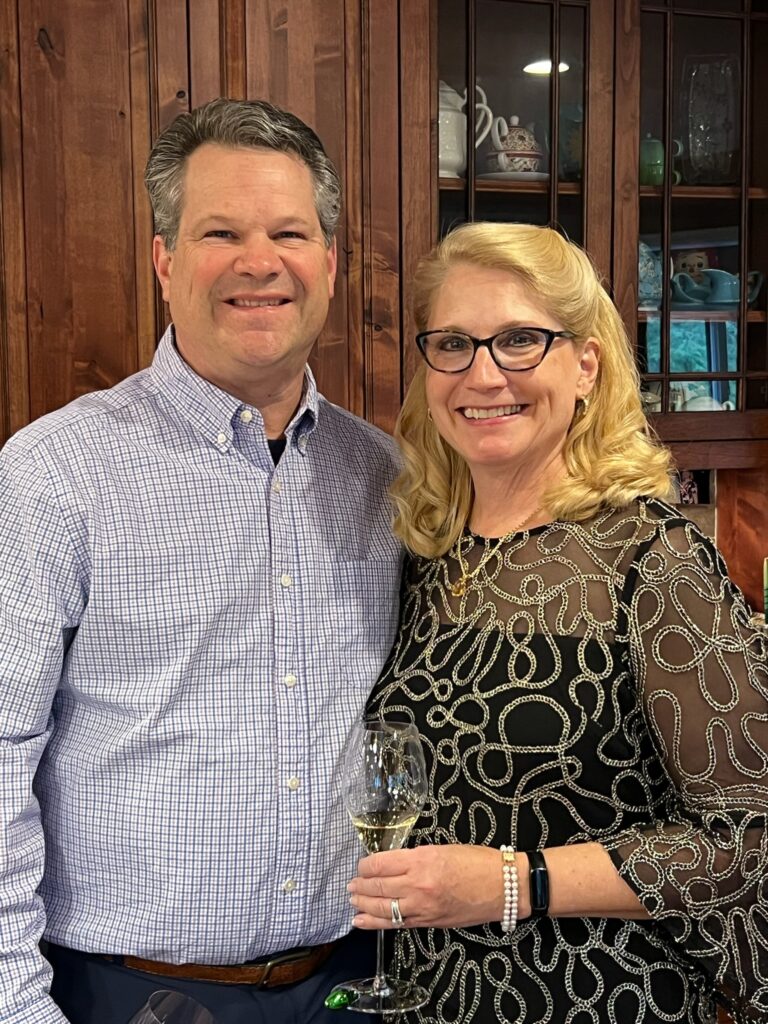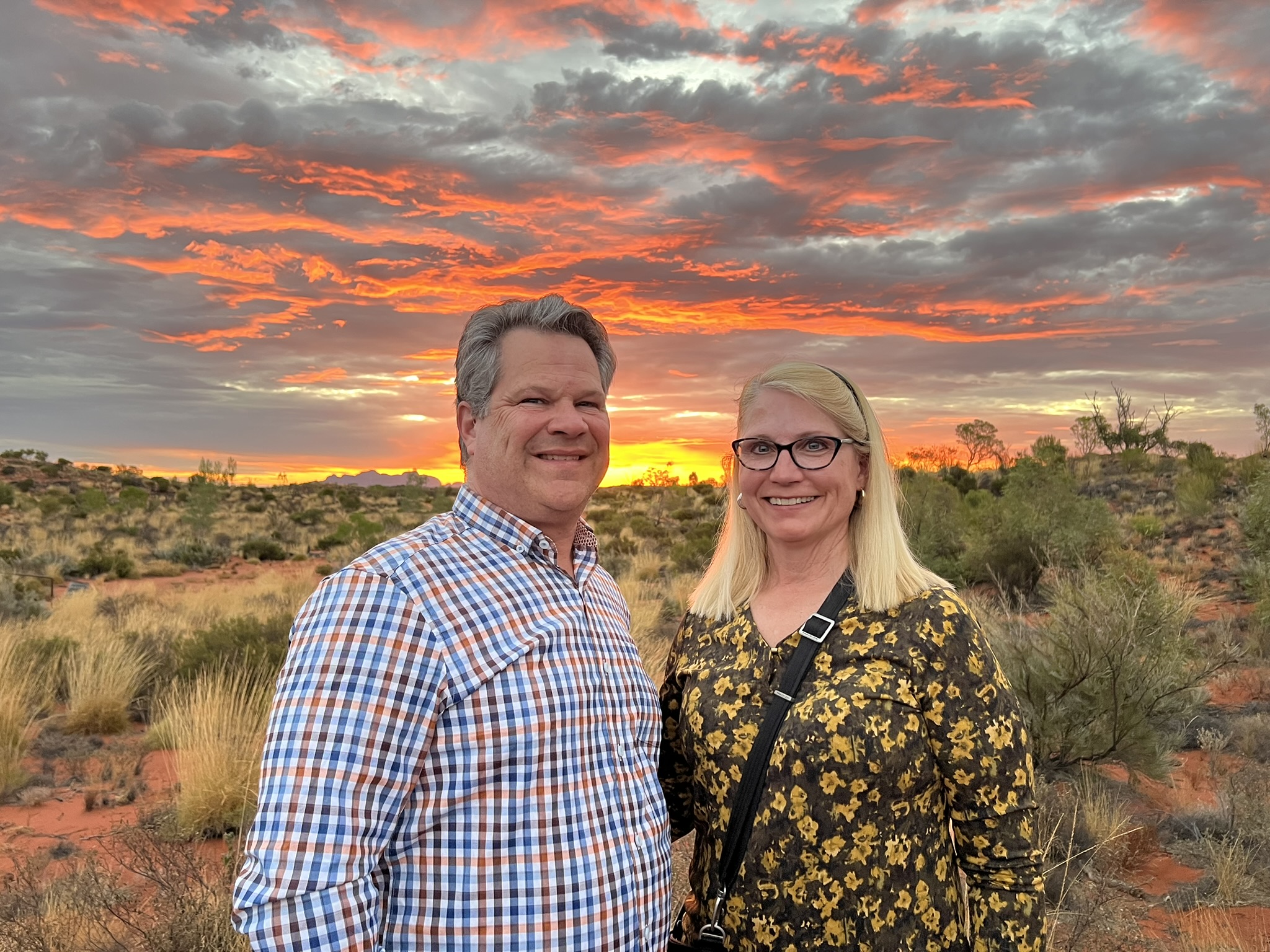Day 27
Today was a travel day. We were up and out the door headed to the airport by 8:15 am. We caught a flight to Alice Springs and got a rental car to drive to Uluru. It was 4 hours and 45 minutes of very monotonous driving. The road continued straight ahead for as far as the eye could see. The most interesting things we saw were the “Floodway” signs and water level gauges. Many people have SUVs with air-intake high mount snorkels, so that they can drive through rivers or these floodways. Although monotonous, it was also interesting to see the “vastness” of the country – no civilization in any direction, yet a landscape that was still beautiful in its own way.
Over the nearly 5 hours of driving, we had to pass one truck and were passed by only one “local”. We saw maybe 20 cars going the opposite way.






We arrived and checked into the Sails in the Desert hotel and grabbed a quick dinner. Our hotel is part of the Ayers Rock Resort community. There are three hotels, plus a campground. They have a post office, some retail shops, an IGA grocery store, and a Shell gas station. There are also multiple restaurants at the various hotels, which are all within walking distance as long as it’s not too hot. They provide a continuous bus to transport people between the locations.
Day 28
We had a slow start to our day. Pat got up early and started our laundry at 6:45 am at the Guest Laundry room (2 washers and 2 dryers – no charge!). We worked on the blog and organized some future activities on the trip. Around noon, we headed to the pool for some lunch and relaxation. Pat decided to try out the pool and expected the water to be warm, as the week prior to our arrival the temperatures were well over 100o F. Apparently, they do a good job of recirculating the water, because it was “refreshing” – probably around 80o F.
Our big event for the day was the Wintjiri Wiru Sunset Dinner. We were picked up at our hotel for a short journey to our destination in the desert. We walked on an elevated boardwalk to an open-air theatre, set upon a dune top.



We were greeted with a drink and then began another culinary adventure using native ingredients.




We then were welcomed to the theater and presented with a “hamper” that contained our gourmet dinner (which included smoked kangaroo and emu) and dessert for the evening. The food was very good, but frankly after all the welcome food at the cocktail reception, it was too much. The staff was very generous with the alcohol, continuously walking around to refill glasses or offer cold cans of beer.
The entertainment for the evening was a drone show that told the story of the Mala, Aboriginal people who came from the north and were drawn to Uluru. Similar to Greek and Roman mythology to explain the forces of nature, the Anangu have many stories to explain their surroundings. The legend has been passed down verbally for thousands of years and tells the origin of Uluru. There are many stories like this that are sacred to the Anangu, and we were specifically asked not to tell the stories away from the area near Uluru.
The drone show was quite amazing, lasting for about 20 minutes. In addition to using 1,200 drones, the production included seven projectors to provide visual effects at ground level, as well as six lasers. And finally, they had a kick-ass sound system that filled the amphitheater with great audio accompaniment. Pictures were not permitted during the performance, but Cheryl found a representative picture on the internet promoting the experience.
Overall, this was a great experience, and we were happy that we chose the version with the welcome reception.




Day 29
We started today very early for our Segway experience at Uluru. We were picked up by a medium-sized bus (20 person capacity) at 5:55 am. After a drive of about 30 minutes, we had a “breakfast tailgate” in a parking lot, giving us a chance to take some pictures.



We then made our way to one of the trailheads for a walk to one of the waterholes. You can see some water in the second picture, however, Blaez, our guide, noted that this is the driest he has seen the waterhole.



He also pointed out some key things on Uluru, as well as around the base. For instance, this particular area was used as a hunting training ground for young men.



He also explained that in current times, Australia has over 1.4 million camels – even more than in the Middle East, as they “export” them to some countries in Africa and Arabia. The camels, along with horses, were brought to Australia during early settlement (in the 1800’s). As motor vehicles took over transportation, the camels and horses were turned loose. Without any natural predators, they both thrived, and Blaez said at the peak, there were over 3 million camels in Australia! Through culling and exporting, they’ve been able to reduce it by 50% to the current level.
In terms of the feral horses, which are called “brumby”, they can be very aggressive. Blaez indicated when he is in the Outback, he’s most worried about crossing paths with a brumby (or brumbies), more so than snakes. Speaking of “feral” and invasive species, Australia has been devastated by a number of these. Feral cats (former housecats) have single-handedly eradicated 27 of their native species – primarily small marsupials. Similarly, “forest mismanagement” led to the intentional introduction of a wild grass species from South Africa that chokes out native vegetation. It is everywhere throughout the Outback, but it isn’t edible to any native species (kangaroos, emus, etc). Too make matters worse, it’s almost impossible to kill, with a deep root system and the ability to regenerate quickly even after a bush fire. This has dramatically changed their ecosystem, and they’re working to try to eradicate small sections at a time, presumably through the use of herbicides, but that is likely controversial in it’s own right.
After our short walk, our group was introduced to riding on our Segways. We had previously been on a Segway tour, so we were easily able to manage the training course before our circumnavigation of Uluru.




Over the two hour tour, we stopped many times to hear stories of the area. Along the back side of Uluru we were unable to take pictures, out of respect for the sacred ceremonies that took place on those sites. Interestingly, there are men’s ceremonies and women’s ceremonies of which neither group is allowed to know about or go the other’s site where the ceremonies take place. It is considered “Men’s business” and “Women’s business” and never shall the two meet.
The last site we visited was where people used to climb Uluru. Sean’s girlfriend, Moriah, actually made this climb when she was a young girl. It is incredibly steep and there is no way we would be comfortable doing this!!!



This practice was stopped in 2019, due to its spiritual significance of the monolith to the Anangu people and the dangers associated with the climb (on average 3 people died each year). The site is monitored with cameras and there is a $10,000 fine if caught. In the last 5 years, only 3 teenage boys have attempted to climb and they were caught.
We truly enjoyed the 10km Segway tour around Uluru. In fact, that was Pat’s favorite excursion while we were visiting here at the Red Centre. While riding a Segway is fun, Pat most enjoyed the commentary that Blaez provided. He is well versed in Aboriginal culture and customs, and is passionate about protecting the Outback. Without Blaez, we certainly would have missed many key features or areas of interest.
Later that evening, we once again headed out to the buses for the Field of Light Uluru Dinner. When we arrived at our destination, we enjoyed some refreshing sparkling wine and interesting canapes while we admired Uluru in the distance. As the sun began to set over Kata Tjuta, we witnessed the most stunning sunset of our lives.



During cocktails, we met an interesting couple from Calgary, who were also recently retired. We dined with them along with 5 other younger travelers (24 to mid-thirties), including a recently married couple from NY/NJ (the 30-somethings), a brother and sister from London, and a woman from Belgium traveling solo. The conversation was very interesting, and we were surprised that they were on holiday for 5-6 weeks at such a young age. They indicated that COVID really changed the perspective of the younger generation and that they shouldn’t wait to do things. Carpe Diem!
Part of the entertainment for the evening was a man playing the the music of a didgeridoo. This is a traditional Aboriginal instrument which produces a unique, pulsating drone with a hypnotic quality.
Dinner was a buffet including salads, barramundi, kangaroo, and lamb lollipops and some sides. The food was just “OK”, but we definitely enjoyed dining with our new friends. As dinner wrapped up, one of the staff members provided a discussion on the skies over the Southern hemisphere. Although it was cloudy, it was still very interesting, and towards the end of the discussion, the clouds started to break.
Finally, it was time for our walk through the Field of Light created by artist Bruce Munro. We made our way to the huge field covered with 50,000 LED lights that slowly changed colors continuously. It was very beautiful.
It took about 20 minutes to make our way through the route, which ended near the bus parking. We returned to our hotel around 11pm, tired from a long day that began at 5am.







4 responses to “Uluru – Palya (welcome)”
That has to be one of the top sunsets I have ever seen…! I can’t even imagine how magical the Field of Light was to see in person! New reason to travel to Australia unlocked!!
Megan,
There are a million reasons to come to Australia – this has already been such a fantastic trip and we’re not even halfway through! The Field of Light was supposed to be a temporary exhibition, however, due to the continuing popularity, they decided to make it a permanent installation. So it will be on display when you get here, although something tells me you will do it before you’re 60, being that you and Derek are world travelers and have already seen more than we have!
XOXO,
Mom
The handful of times I’ve ever been near a horse in my life I’ve always walked away calling them magnificent because of their size and muscular build. Never did the concept of a feral horse occur to me, now I can easily imagine it wouldn’t be a good idea to provoke a feral horse.
Sorry for the tardy reply. Yes, horses are such powerful, regal animals. They are also extremely intelligent. On the rare occasion I’m around a horse, I always speak in a soothing manner and give it neck and muzzle rubs. On a recent horse riding excursion in Argentina back in October, my horse started following me around after I dismounted for a rest break, as we had “connected”.